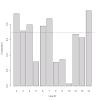Feasibility of collecting diary data from asthma patients through mobile phones and SMS (short message service): response rate analysis and focus group evaluation from a pilot study
- PMID: 15631966
- PMCID: PMC1550628
- DOI: 10.2196/jmir.6.4.e42
Feasibility of collecting diary data from asthma patients through mobile phones and SMS (short message service): response rate analysis and focus group evaluation from a pilot study
Abstract
Background: Self-management of asthma may improve asthma outcomes. The Internet has been suggested as a tool for the monitoring and self-management of asthma. However, in a recent study we found that a Web interface had some disadvantages and that users stopped using the application after a short while.
Objective: The primary objective of this study was to evaluate, from a user perspective, the feasibility of using short message service (SMS) for asthma diary data collection through mobile phones. The secondary objective was to investigate patient compliance with an SMS diary, as measured by response rates over time.
Methods: The study included quantitative response rate data, based on SMS collection, and qualitative data from a traditional focus group setting. In a period of 2 months, the participants received 4 SMS messages each day, including a medication reminder, a request to enter peak flow, data on sleep loss, and medication dosage. Participants were asked to reply to a minimum of 3 of the messages per day. Diary inputs were collected in a database and the response rate per patient was expressed as the number of diary inputs (SMS replies) divided by diary requests (product of number of days in the study and the number of diary questions per day) for each participant. After the study period, the participants were invited to a focus group interview addressing the participants' attitudes to their disease, their experience with the SMS asthma diary, and their future expectations from the SMS asthma diary.
Results: Twelve patients with asthma (6 males, 6 females) participated in the data collection study. The median age was 38.5 (range: 13-57) years. The median response rate per patient was 0.69 (range: 0.03-0.98), ie, half the participants reported more than about two thirds of the requested diary data. Furthermore, response rates were relatively steady during the study period with no signs of decreasing usage over time. From the subsequent focus group interview with 9 users we learned that, in general, the participants were enthusiastic about the SMS diary--it became an integrated part of their everyday life. However, the participants wished for a simpler diary with only one SMS message to respond to and a system with a Web interface for system customization and graphical display of diary data history.
Conclusion: This study suggests that SMS collection of asthma diary data is feasible, and that SMS may be a tool for supporting the self-management of asthma (and possibly other chronic diseases) in motivated and self-efficacious patients because mobile phones are a part of people's everyday lives and enable active requests for data wherever the patient is. The combination of SMS data collection and a traditional Web page for data display and system customization may be a better and more usable tool for patients than the use of Web-based asthma diaries which suffer from high attrition rates.
Conflict of interest statement
None declared.
Figures



References
-
- Global Strategy for Asthma Management and Prevention. GINA Workshop Report. NIH Publication No. 02-3659 . 2002. Apr, http://www.ginasthma.com/workshop.pdf.
-
- Gibson PG, Powell H, Coughlan J, Wilson AJ, Abramson M, Haywood P, et al. Self-management education and regular practitioner review for adults with asthma. Cochrane Database Syst Rev. 2003;(1):CD001117. - PubMed
-
- AstraZeneca A/S. LinkMedica Asthma. Albertslund, Denmark: http://www.linkmedica.dk/
-
- Anhøj Jacob J, Nielsen Lene L. Quantitative and qualitative usage data of an Internet-based asthma monitoring tool. J Med Internet Res. 2004 Sep 8;6(3):e23. doi: 10.2196/jmir.6.3.e23. http://www.jmir.org/2004/3/e23/v6e28 - DOI - PMC - PubMed

